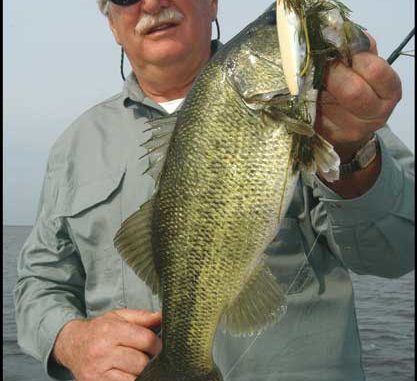
This is the month when trophy trout go crazy on Calcasieu Lake.
It’s the end of spring, and the peak of marsh bass fishing is past. Marshes near the Mississippi and Atchafalaya rivers are still brown with river water, and everywhere else in the marshes, aquatic plants are going into their summer growth period. Marsh bass, in spite of looking and acting a little different than bass elsewhere, are the same species, Micropterus salmoides. Brackish marsh bass are often considered by anglers to be smaller but more plentiful than freshwater bass from non-marsh areas.
Also, bass anglers frequently described them as having a more stocky body build, or being “chunkier,” than other bass. From these differences, the question often arises as to whether marsh bass are genetically different from other bass or whether the differences are due to different habitat.
In the late 1980s, biologists at the LSU School of Forestry, Wildlife and Fisheries looked closely at brackish marsh bass to see if they could answer some of these questions. They conducted both lab and field studies.
For the lab study, 24 fish were collected from brackish-water canals and marshes near Cut Off. Salinities in this area averaged 2 parts per thousand (ppt). For comparison, full-strength seawater is about 35 ppt salinity.
Another 24 fish were taken from Ben Hur Lake on the LSU Aquaculture Research Station, which is fresh water at 0 ppt.
All the bass were held for two weeks to settle down and actively begin feeding before any experiments began. The freshwater fish were held at 0 ppt salinity, and the marsh bass were started at 2 ppt, with salinity gradually being reduced to 0 ppt. Each fish had its own tank.
The bass were then assigned equally to one of four categories of salinities — 0 ppt, 4 ppt, 8 ppt or 12 ppt. Salinities were increased gradually by 1 ppt per day, until the final salt concentration was reached. The whole time, the bass were fed live golden shiners in an amount equal to 2 percent of the weight of each bass. Each fish was weighed before and after the 20-day experiment to determine growth rates.
All the bass, both marsh and freshwater, in the 12-ppt tanks stopped feeding within one week, and died before the experiment ended. No difference in growth rates occurred in the marsh bass held at 0 ppt, 4 ppt and 8 ppt, and the growth rate for freshwater fish at 0 ppt and 4 ppt was the same.
However, the growth rate of freshwater fish held at 8 ppt was lower than for those held at 0 ppt. When the two groups were compared, marsh bass outgrew freshwater bass at 8 ppt, and freshwater bass grew faster than marsh bass at 0 ppt.
At 4 ppt, growth rates were the same.
In the field studies, 133 marsh bass were collected from the same marshes over 12 months. These fish were compared to 115 freshwater bass collected from False River.
The results of the detailed measurements made agreed with fishermen’s observations. Bass from brackish marshes do have a stockier body build. Length at each age for the first four years of their life was then back-calculated for both groups of bass. The analysis showed that at each age, freshwater bass were longer than marsh bass, especially for age 1 and 2 fish.
Examination of the stomach contents of the marsh bass collected showed a high percentage of invertebrates (animals without backbones) compared to the typical diet of adult largemouth bass. Grass shrimp were the most common food item by count, and brown shrimp were the most food item by weight.
The most common fish eaten were gulf killifish (cocahoes), silversides (glass shiners) and menhaden (pogies). Fish are generally considered to be a superior food item to invertebrates for producing growth in predator fish such as largemouth bass.
The biologists noticed large numbers of gulf killifish and menhaden in the open waters of the canals, yet the marsh bass preferred to stay in underwater grass beds that held less prey fish. They suggested that marsh bass stayed in the grass beds, even though the food supply was poorer, because the grass beds provided protection from even larger predators such as alligators, redfish and alligator gar.
They noted that 40 percent of the bass they collected from the marsh had open wounds or scars. In marshes, largemouth bass are in the middle of the food chain, rather than near the top, as they are in most freshwater habitats.
The researchers concluded that the differences in growth and body shape of marsh bass are due to salinity, food availability, and the risk of being eaten by larger predators. Overall, however, the marsh environment was still considered excellent for largemouth bass.
Jerald Horst is an author of the Angler’s Guide to Fishes of the Gulf of Mexico, a 444-page, color-illustrated book on fishes written for saltwater fishermen. The book is available in better bookstores, or can be ordered by calling (800) 843-1724.


